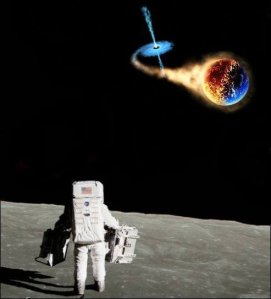

Picture it: Your first day free from work in months. The crisp autumn breeze is blowing through the air. You decide to go for an invigorating bike ride to feel the wind surging through your lungs and flying through your hair. You go to the shed to get your bike… and your planet is eaten by a black hole. Unfortunate, but it happens (and believe it or not, things could be worse).
Okay, so perhaps the image on the right isn’t the most realistic rendition of a planet being consumed by a black hole, but similar events do occur. In fact, scientists announced last year that they had discovered a black hole chowing down on what seems to be a giant rogue planet, or a super-Jupiter. However, if the upper limit estimates are correct, the “planet” in question — a body with the mass of 14 to 30 Jupiters — could actually turn out to be a brown dwarf (brown dwarfs are substellar objects that are a little bit too massive to be gas giants, but too light to be stars).
An Abnormal Signal:
The initial discovery was made by ESA’s Integral space observatory. The ESA reported, “Astronomers were using Integral to study a different galaxy when they noticed a bright X-ray flare coming from another location in the same wide field-of-view.”
The X-rays turned out to be coming from the black hole located at the center of galaxy NGC 4845 (about 47 million light-years from Earth). This beast is estimated to be about 300,000 times more massive than the Sun, which is rather large and frightening, but 47 million light-years is a long way to travel, so it is of little consequence to us logistically.
The ESA went on to say that it seems “that only its external layers were eaten by the black hole, amounting to about 10 percent of the object’s total mass, and that a denser core has been left orbiting the black hole.”
[Reference: Astronomy Magazine]
The Debate Continues:
It’s a fine line between the two classifications, indeed. Some recent discoveries have shown that our models need more work. on both ends of the spectrum. Take GJ 504b, a gaseous, bubble gum pink planet found earlier this year, for example. We’ve found that it’s so lightweight, it challenges our formation models. Kappa And b has the opposite problem. Its so large, astronomers aren’t even sure what to make of it. Such things prove that we have an incomplete puzzle
Either way, it seems that kids aren’t the only picky eaters in the cosmos…many others also refuse to eat all their dinner. Our supermassive black hole appears to be one of them. Over the last forty years, minimal activity tied to Sagittarius A* has been detected in the central portion of the Milky Way. That’s not to say Sag A is dead. Astronomers have been able to witness neighboring gas clouds as they were ripped to shreds by an unseen force, mostly because simulations placed said clouds right within the path of our black hole, thus we knew where and when to look. That is a rarity given how vast our galaxy is.